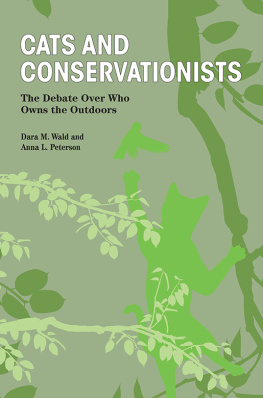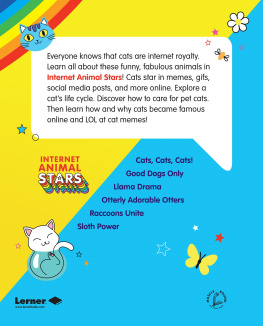
CATS AND
CONSERVATIONISTS
NEW DIRECTIONS IN THE HUMAN-ANIMAL BOND
Series editors: Alan M. Beck and Marguerite E. OHaire, Purdue University
A dynamic relationship has always existed between people and animals. Each influences the psychological and physiological state of the other. This series of scholarly publications, in collaboration with Purdue Universitys College of Veterinary Medicine, expands our knowledge of the interrelationships between people, animals, and their environment. Manuscripts are welcomed on all aspects of human-animal interaction and welfare, including therapy applications, public policy, and the application of humane ethics in managing our living resources.
Other titles in this series:
Transforming Trauma: Resilience and Healing Through Our Connections With Animals
Philip Tedeschi and Molly Anne Jenkins (Eds.)
A Reason to Live: HIV and Animal Companions
Vicki Hutton
That Sheep May Safely Graze: Rebuilding Animal Health Care in War-Torn Afghanistan
David M. Sherman
Animal-Assisted Interventions in Health Care Settings: A Best Practices Manual for Establishing New Programs
Sandra B. Barker, Rebcca A. Vokes, and Randolph T. Barker
Moose! The Reading Dog
Laura Bruneau and Beverly Timmons
Leaders of the Pack: Women and the Future of Veterinary Medicine
Julie Kumble and Donald F. Smith
Exploring the Gray Zone: Case Discussions of Ethical Dilemmas for the Veterinary Technician
Andrea DeSantis Kerr, Robert Pete Bill, Jamie Schoenbeck Walsh, and Christina V. Tran (Eds.)
Pet Politics: The Political and Legal Lives of Cats, Dogs, and Horses in Canada and the United States
Susan Hunter and Richard A. Brisbin, Jr.
Free Market Dogs: The Human-Canine Bond in Post-Communist Poland
Micha Piotr Prgowski and Justyna Wodarczyk (Eds.)
Teaming With Your Therapy Dog
Ann R. Howie
Come, Let Me Guide You: A Life Shared With a Guide Dog
Susan Krieger
CATS AND
CONSERVATIONISTS
The Debate Over Who
Owns the Outdoors
Dara M. Wald and
Anna L. Peterson
Purdue University Press, West Lafayette, Indiana
Copyright 2020 by Purdue University. Printed in the United States of America.
All rights reserved.
Cataloging-in-Publication data is on file at the Library of Congress.
Paperback ISBN: 978-1-55753-887-1
ePub ISBN: 978-1-55753-888-8
ePDF ISBN: 978-1-55753-889-5
Contents
Chapter 1
Introduction
Chapter 2
The Cat Problem
Chapter 3
The Science Problem and Framing
Chapter 4
The Values Problem
Chapter 5
The Social Problem
Chapter 6
Conclusions
The idea for this book began when Dara was a graduate student in the Department of Wildlife Ecology and Conservation at the University of Florida. Several months into her second year in graduate school, she brought her adviser, Susan Jacobson, an outline of her dissertation proposal to review. Susan, an extremely supportive and patient advisor, handed the document back and informed Dara that she had written a book outline instead of a thesis proposal and she couldnt possibly complete this effort in four years. Fortunately, with Susans help, Dara was able to whittle the proposal down to several manageable chapters for her dissertation, but the idea for a book stuck. The interviews and research described here would not have been possible without Susans advice and encouragement.
This project was made possible by Katie Sieving, who introduced Dara and Anna several years ago and provided valuable feedback on earlier drafts of this book. Thank you to Julie Levy for connecting Dara with members of the TNR community and to Lynette McLeod for graciously sharing her data with us. Special thanks to research assistants Denise Coberley, Emily Haberlack, Madelyn Huinker, Iris McFarlin, Kimberly Nelson, Priscilla Raile, and Amanda Schuler for helping us stay organized.
We want to acknowledge the contributions of all of the research participants and organizations who supported this effort. Financial support for much of the data described in this book was provided by the NSF Doctoral Dissertation Improvement Grant in Decision Risk and Management Sciences, the Morris Animal Foundation, the Doris and Earl and Verna Lowe Scholarship, the University of Florida Department of Wildlife Ecology and Conservation, and the College of Liberal Arts and Sciences at Iowa State University.
We appreciate the helpful comments from two external readers and enjoyed working with the Purdue editorial team, including Justin Race and Katherine Purple.
Finally, we would like to thank our families for their support, advice, and patience.
CAT WARS?
Outdoor cats are ubiquitous throughout the United States. Tens of millions of cats live outdoors. Estimates of the countrys feral (unowned) cat population range from 25 to 50 million, and almost that many owned cats spend at least part of their days outside. They are literally part of the scenerya brief flash crossing a street at night, a lone sentinel waiting on a corner, or perhaps a minor annoyance digging in the garden or stalking birds on the lawn.
Although neighborhood cats are everywhere, most people around the world pay them little mind, as felines and humans alike go about their daily routines. However, in the past few decades, sporadic irruptions in the press reveal a wellspring of strong feelings about free-roaming outdoor cats and their presumed ecological damage. A recent book, titled Cat Wars, refers to the battles being fought on several fronts over the cats. The subtitleThe Devastating Consequences of a Cuddly Killerreflects the perspective of people who believe that outdoor cats kill large numbers of song birds and other wild animals and pose a potential risk to human health. Conservation organizations, especially those concerned with wild birds, have been at the forefront of the effort to remove (and often kill) outdoor cats, as a way to protect birds and other animals, including endangered species. Their goal is to eliminate, or at least limit, the threat that cats pose to native wildlife.
For many conservation-minded groups, outdoor cats fall into the same category as other invasive animals, including domesticated species such as hogs, goats, and exotic (non-native) wild creatures like Burmese pythons. When invaders threaten both native animals and overall ecological integrity, resolving the problem is critical and often requires a lethal solution.
On the other side of the cat wars stand people who deny that cats and pythons fall in the same category. They believe that outdoor cats, owned or unowned, should be able to live healthy lives and that lethal management approaches are inhumane. Many people who share this perspective support trap-neuter-return (TNR) projects, which aim to keep cats healthy and limit population growth. Thousands of volunteers participate in TNR projects, and in addition to trapping and returning the cats, they often provide food to colonies where outdoor cats congregate and volunteers can watch out for sick or injured cats, orphan kittens, and others in need of care. TNR has widespread support from local and national humane organizations, including cat-specific groups such as Alley Cat Allies, many programs run through public animal services agencies, and countless small, volunteer-led projects (see ). In all cases, the goal is to allow the cats to live outdoors in peace, with the best welfare possible, while limiting excessive population growth through ongoing spay and neuter of new cats.
Next page













